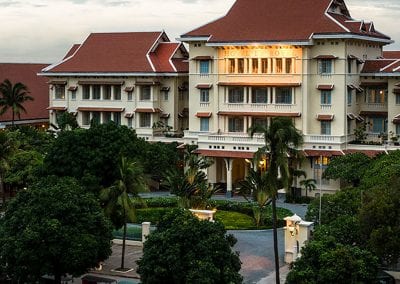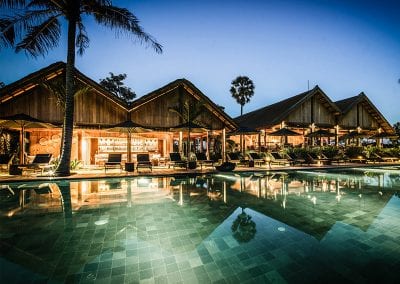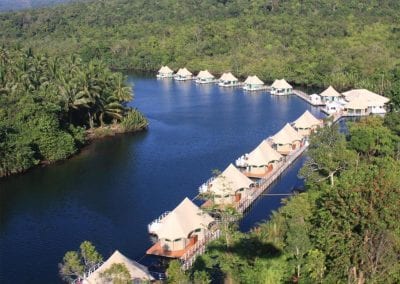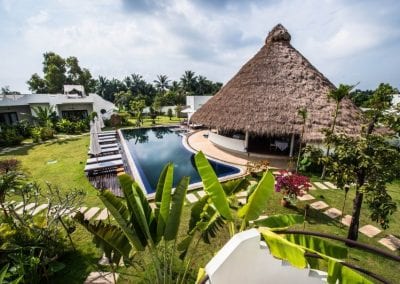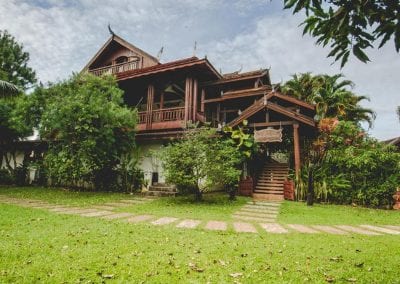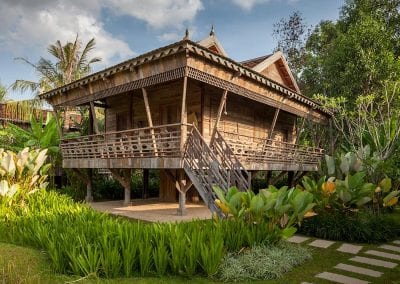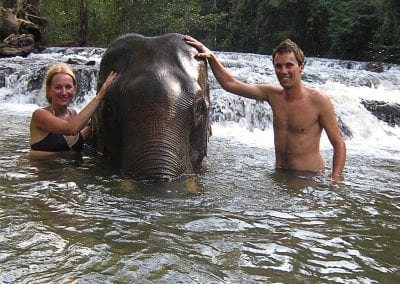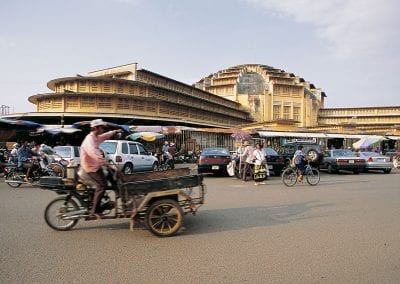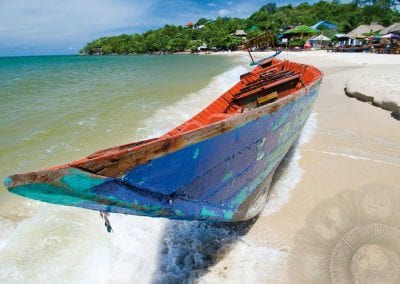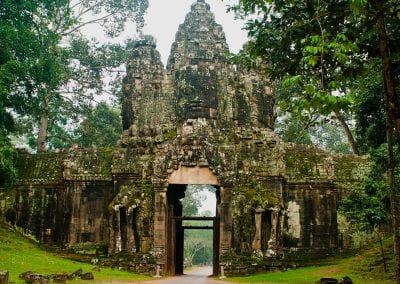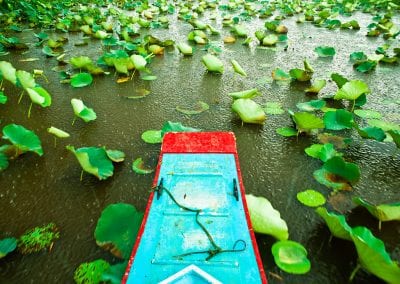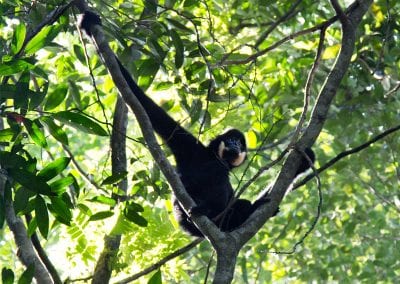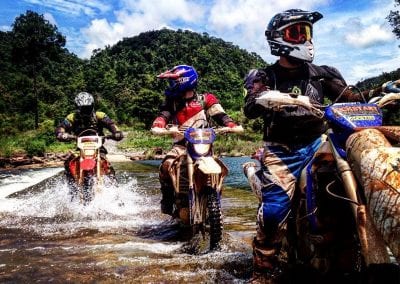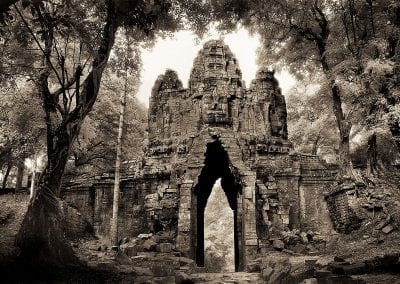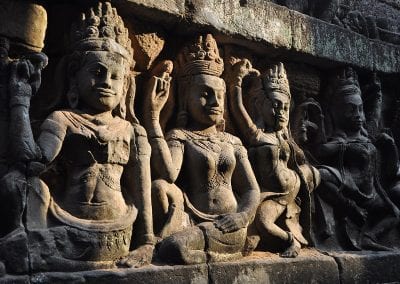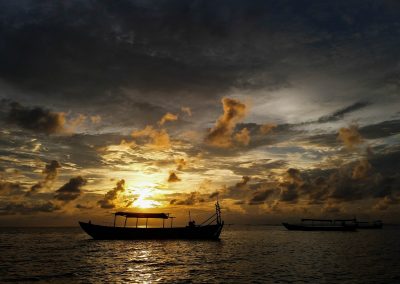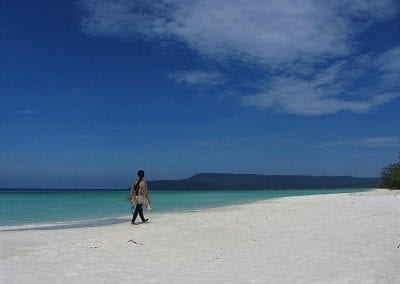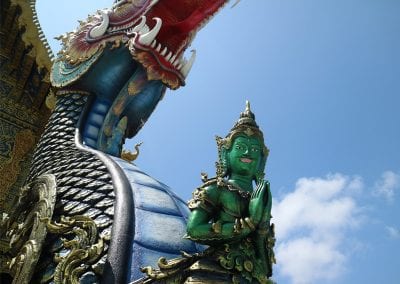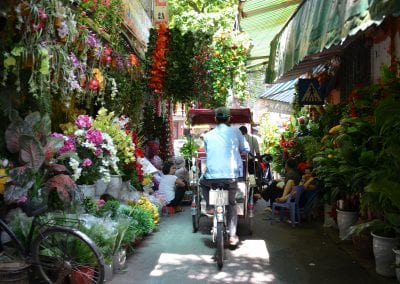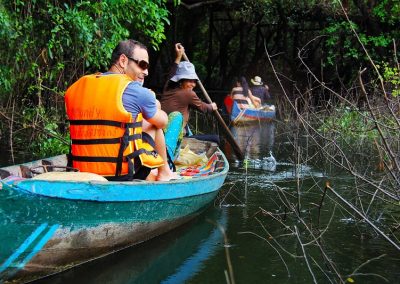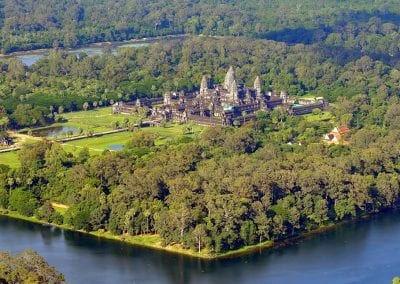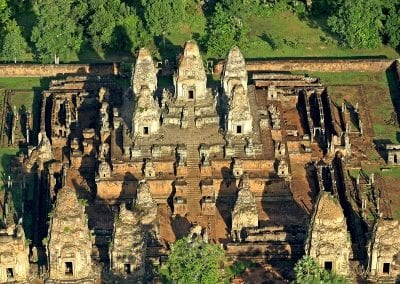JANUARY
If you want to see Angkor Wat or any part of Cambodia, January is one of the best months for a visit. The moderate climate makes long treks or temple explorations much less of an endurance test (though you will probably still be grateful for mid-day shade!).
With an average temperature of 26°C, you can expect relative coolness, cloudless skies, and little to no rainfall. If you venture further north to the mountain areas of Ratanakiri or Mondulkiri, you will enjoy even lower temperatures – 20°C on average.
The beaches and islands on the south coast, from Sihanoukville and Koh Kong over to Kampot and Kep near the Vietnamese border, enjoy splendid sunshine during January, with very little chance of rain. The temperate sea and dry weather conditions are also perfect for diving – at this time of the year the waters surrounding the islands of Koh Rong Samloem and Koh Rong positively teem with marine life.
FEBRUARY
The whole of Cambodia enjoys splendid weather in February. The hot season is not too far away, so temperatures may rise slowly but steadily as the month progresses. But it’s still relatively cool, with an average of about 27°C country-wide.
The beaches of Sihanoukville, Kep and Koh Rong to the south see little rain and enjoy plenty of sunshine. Diving is superb at this time of year, with clear visibility and warm water temperatures; the tropical islands of Koh Rong Samloem and Koh Rong are great bases for diving in February.
Of course, most visitors to Cambodia want to see the amazing Angkor Wat temples, and the moderate temperature in February makes exploring these much more manageable. The same goes for those other popular tourist destinations – the northeast provinces of Ratanakiri and Mondulkiri. Though you may still be grateful for some shade around mid-day!
MARCH
Cambodia experiences excellent weather in March. There is little to no rain and days are sunny and dry. Throughout the country, temperatures average around 30°C, but it will be a little cooler in Ratanakiri and Mondulkiri to the northeast.
At this time of year, a whole day in the temples of Angkor Wat can be a little trying. It’s a good idea to make an early start and take a mid-day break back in the comfort of your hotel.
March is a great month for diving – the beaches of Sihanoukville, Koh Kong and Kep on the south coast bask in sunshine and there is very little chance of rain.
APRIL
With temperatures averaging around 35°C (possibly nudging towards the 40°Cs), April is not the coolest month in Cambodia. The rainy season is not too far away (it normally starts raining in early-mid May), but April is mainly dry, with the possibility of the occasional shower towards the end of the month.
Under these hot conditions exploring the Angkor Wat temples can be tiring, so rather than whole day visits, it might be an idea to schedule shorter stints throughout the day. There is an upside – the popular temples will have fewer visitors at this time of year, giving you more room to enjoy this once-in-a-lifetime experience.
April is also the perfect time to enjoy a few days of relaxation on the south coast beaches of Kep, Sihanoukville, or the islands, Koh Rong or Koh Rong Samloem. Here you can really make the most of the hot sunshine.
Something to bear in mind: ‘slash and burn’ farming is an unfortunate practice at this time of year in most of Asia. In February new ground is cleared. Once it’s dry, any bush and wood that can’t be used is burnt. The fires lit country-wide can cause haze, especially in rural areas.
MAY
May sees the onset of the rainy season, but the early part of the month is still relatively dry. By the end of the month, the rainy season is usually underway across Cambodia, although the rainfall is sporadic at first.
Despite the heat, the rain eases humidity, making life quite comfortable, with average temperatures of 29°C. It’s easy to enjoy a very pleasant month in Cambodia if you build your day around the short, heavy downpours. Another advantage is that the crowds at the Angkor Wat temple complex will be thinner.
All in all, May is a great month for a visit to Cambodia. There is still plenty of sunshine, and there are fewer visitors than in previous months. The south coast beaches in Kep and Sihanoukville are still great destinations because the temperatures are warm and the showers are short and infrequent.
Slash and Burn
There is an unfortunate farming practice in April and May throughout most of Asia: slash and burn. In February, new ground is cleared. Once the wood is dry, any wood and bush that can’t be used is burnt off. The fires lit across the country can create haze, especially in the countryside.
JUNE
Rain is to be expected throughout Cambodia in June. At an average of 28°C, temperatures remain high. Humidity can reach a high of 70% during the day, but life is made more comfortable by the heavy, intermittent showers.
The Cardamom Mountains and the beaches on the south coast, such as Sihanoukville and Kep, bear the brunt of the rain. In some areas, like the rural north east, Mondulkiri and Ratanakiri, travelling can be quite difficult at this time of year, due to the rain.
Between the showers, there is no lack of sunshine, so June can be a pleasant month for a visit to Cambodia. There are far fewer visitors than in previous months and some good low season hotel deals can be found.
JULY
July sees a continuation of the rain, though there are still dry days. Temperatures gradually drop (averaging around 27°C), which makes life more comfortable during the daytime.
This is still a good month to visit Cambodia – the showers are usually heavy but short-lived, and it’s possible to plan your day around them. The rainfall does tend to increase nearer the end of the month. There are occasional spectacular thunderstorms – especially around the Angkor Wat temple complex.
In the rural areas, such as Mondulkiri, and the south coast beaches of Kep and Sihanoukville, the rain can be heavier and last longer, though there are still dry days. Due to the rain, Cambodia’s south coast beaches may not be the ideal destination at this time of year, but central Vietnam’s beaches are at their best in July, and an excursion there can be easily integrated into a tour of Cambodia.
AUGUST
The rainfall has almost reached its peak by August. The downpours are usually short and intense – tending to last a couple of hours instead of all day. The countryside is consequently lush and green. The water level on the central Tonle Sap Lake is high, so the floating villages and flooded forests can be visited by boat. Temperatures average around 26-27°C, which is quite comfortable.
The south coast sees the heaviest rainfall, so this may not be the best time of year for a visit to Cambodia’s beaches. However, the Vietnamese beaches of Danang and Hoi An are usually sunny and dry at this time, and are only a short hop away.
The heavy rain can cause problems in the rural northeast areas, such as Mondulkiri and Ratanakiri, often rendering tracks unpassable. ‘Off the trail’ travel is best avoided in August.
SEPTEMBER
Expect September to be warm and wet with average temperatures of 26°C and fairly heavy rain. It usually only rains for a few hours rather than all day, though it sometimes does rain all day.
The countryside is in full bloom, lush and green. There are excellent photo opportunities for temple reflections in water: the pools and moats that surround the Angkor temples are full at this time. There are far fewer people visiting the Angkor complex, and at some of the remoter temples you could well have the place to yourself. If a thunderstorm occurs, it will be a memorable experience!
The central Tonle Sap Lake grows 5 times in size during the rainy season, so this is the perfect time of year to visit the floating villages and flooded forests.
Rainfall is at its heaviest on the south coast and in rural areas, such as Mondulkiri and Ratanakiri. There you can expect rain to be heavier and last longer. In these regions roads become water-logged and access to remote areas can be problematic.
OCTOBER
The dry season is not too far away, so the rainfall eases off during the course of October, though there are still rainy days. Temperatures are warm, averaging around 27°C.
After months of rain, water levels are now at their maximum, so this is an excellent time of year to enjoy a visit to the floating villages and flooded forests of Tonle Sap Lake, swollen to 5 times its normal size. The north eastern areas of Ratanakiri and Mondulkiri have some spectacular waterfalls to reward the intrepid visitor.
Some rain is still to be expected on the south coast beaches of Kep and Sihanoukville, though the showers become more intermittent and the periods of sunshine longer as we head towards the beginning of the dry season in November.
NOVEMBER
Though intermittent showers may still be encountered during the month, November marks the beginning of Cambodia’s dry season; there will not be much rain for the next six months. Temperatures are comfortable, averaging around 25°C, humidity is low, and with plenty of sunshine to enjoy, November is an excellent time to visit Cambodia.
The relative coolness will make your visit to the Angkor Wat temple complex much more comfortable, though you will still be grateful for some mid-day shade! Water levels are still high, so this is a good time to see the floating villages of Tonle Sap Lake, and the beautiful waterfalls to the north east in Mondulkiri and Ratanakiri provinces. The south coast beaches of Sihanoukville and Kep come back to life, thanks to the calmer seas and moderate, pleasant sunshine.
DECEMBER
In December you can expect dry and sunny conditions and relatively cool temperatures, averaging around 26°C, with low humidity throughout Cambodia. This is one of the most popular months to visit the country.
Visits to the Angkor Wat temples are much easier, with moderate temperatures and little rainfall to contend with. The attractions of Tonle Sap Lake – the floating villages – can still be reached by boat as water levels are still quite high. The beaches on the south coast, Sihanoukville and Kep, are ideal for chilling out, and there are ideal diving conditions on the islands of Koh Rong and Koh Rong Samloem at this time of year.
 Passport & Visa Information
Passport & Visa Information
 Trustpilot
Trustpilot
 Tripadvisor
Tripadvisor
